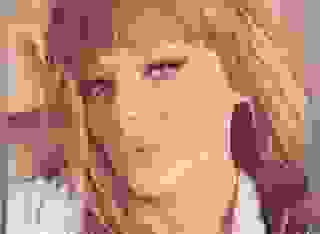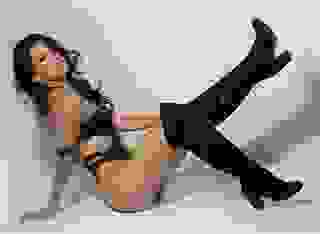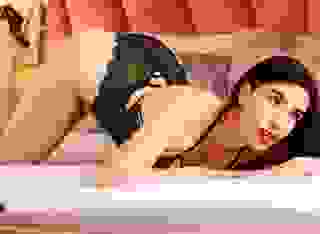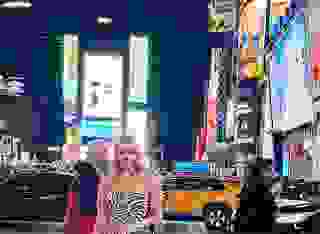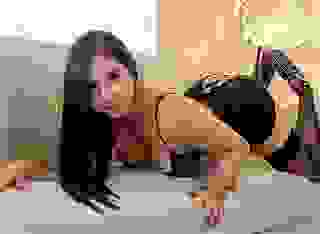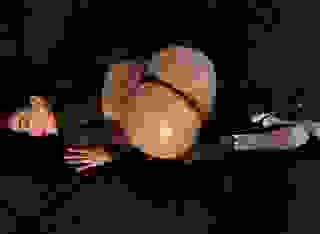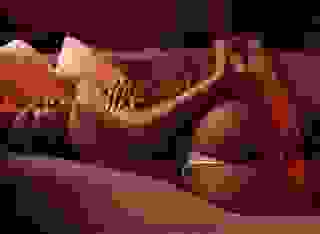Note: You can change font size, font face, and turn on dark mode by clicking the "A" icon tab in the Story Info Box.
You can temporarily switch back to a Classic Literotica® experience during our ongoing public Beta testing. Please consider leaving feedback on issues you experience or suggest improvements.
Click herePeter, on the other hand, felt like he'd been hit by a truck. He stood there and thought, 'I'm going to have to be a little more cautious about how I go about this until I get the hang of it; maybe I should start with a quick high five or the touch on an elbow.' But, after a minute he felt OK again. With a hand in the small of Peter's back, David urged him to walk out of the plaza, across the street, and up a winding road to a large gate in the city wall.
"This is the Lion's Gate. I want you to take note of two things," he said pointing to an area above the gate. "Note the two lions facing one another, thus the name. And the other: take note of the many bullet holes in the wall around the gate. Those were made during the Six-Day War in 1967, when Israel captured East Jerusalem from the Jordanians."
They passed through the gate and immediately entered a city from another time. There were almost no cars, mainly because the streets were so narrow, and people everywhere; many were tourists, but many others were citizens of the Old City.
"We are currently in the Muslim Quarter."
"Are we in any danger here?"
"No, people in the city have learned to live in peace with one another. Occasionally there are protests and disturbances, but for the most part people are too busy living their lives to start any trouble. Trouble is bad for tourism, and tourism is what drives the economy here in the city."
They walked past a church, which had been turned into a Muslim School. They toured an archeological dig that had uncovered several buildings dating from the Roman Occupation. They walked down narrow streets lined with shops of on both sides, selling everything from foods and spices to electronic products. The sky was partially hidden from view by brightly colored sheets of fabric that blew gracefully in the warm breeze.
"This is the beginning of the Via Dolorosa - 'The Way of Sorrows' - which is held to be the route Jesus walked carrying his cross from the Roman Praetorium to his crucifixion and burial. The current route is marked by nine of the Stations of the Cross; the remaining five are located within the Church of the Holy Sepulcher."
"David, can we do the walk today?"
They walked for a while, down winding roads, through alleys, between buildings, and then to Peter's surprise, out the Zion Gate, finally coming to a stop in front of a large church.
"We'll visit the church in a few minutes; first I want to show you the Cenacle or the Upper Room. This is said to be the site of the Last Supper. According to legend, the building that was originally here was not completely destroyed by the Romans and was rebuilt a couple of hundred years later."
They climbed the stairs and toured the room as David continued. "The building has been rebuilt several times since then, serving at one point as a mosque. That window over there points to Mecca. Now let's go see another sacred site."
They climbed down another set of stairs and rounded the corner of the building.
"This, my friend, is the purported tomb of King David. Please take a head cover and come this way."
Around a wall, in the next room was a large sarcophagus, said to be that of King David. The room was unique in that one could not walk around the sarcophagus, only past it. When they left the room David explained.
"The other side of the room is reserved for women. Men and women never pray together in the same room. You may not believe this, but this site is just as sacred to Muslims as it is to us Jews."
They walked across a large courtyard until they came to a rounded building called the Church of the Dormition.
"This church is built on the place that most scholars believe Mary spent the last years of her life, and from here she ascended into heaven."
Peter entered the Church and spent some time examining the ornate mosaics and stained glass of the church and shrine to Mary, and then he met David outside of the Church. They had a pleasant stroll back through the Zion Gate, and then into the Armenian Quarter.
"Let's make our way over to the Jewish Quarter. On the way we can stop at an outdoor cafe I know quite well."
The cafe was situated on one corner of a small plaza formed by the junction of four streets, each coming from a different direction. None of the corners were right angles. In the center of the plaza was a large fountain surrounded by a short iron fence. David spoke to the owner in Hebrew, ordering a platter of fresh vegetables and cheeses and a bottle of red wine.
For the next couple of hours they refreshed themselves. Peter was particularly fascinated by the constant flow of pedestrians and tourists flowing into and out of the plaza. Suddenly, Peter saw something that made his heart skip a beat. Four young soldiers, two men and two women, each carrying a military assault rifle, casually entered the plaza and leaned against the fence. One of the women reached into her backpack; she pulled out a bottle of water and took a short drink. David picked up on Peter's discomfort and glanced over his shoulder.
"Don't worry; that's normal around here. Even though the Old City has been relatively peaceful for the last couple of years, we still must be vigilant. The best way to keep the peace is to make a show of strength. Believe me, here in the Old City the Arabs are just as happy as we are that there's peace. Only the extremists want to start trouble."
"But they're so young."
"That's why they're here in the city and not patrolling in Gaza."
After they had finished their meal, David led Peter through the winding streets of the Jewish Quarter. Peter took in the sights and sounds of the inner city. The shops and the schools were familiar to him; except for the architecture and occasional ruins from a previous millennium, they could have been in the Jewish district in any large city in America.
Soon they came to a series of small plazas and staircases. At the foot of the last staircase they entered the large plaza in front of what is now the holiest site in the Jewish Quarter. In front of them stood the Western Wall. "What you see in front of you is a small part of the Western Wall. The Wall extends northward for close to 425 more meters; however it's mostly hidden by residential buildings that have been built over time. The Wall dates back to the time of Herod the Great and his expansion of the Temple Mount. He built this wall and then had the area behind the wall back-filled to establish a large flat plaza in front of the actual Second Temple. Today the Temple Mount is the home of the Dome of the Rock, which sits on the site of the Second Temple and the al-Aqsa Mosque which is just above this section of the wall.
Muslim leaders have spent much of the last thousand years claiming that the Jewish Temple never existed; because if they or the rest of the world ever admits that the Temples did exist, then they would have to admit that the Israelis have a prior claim to the Temple Mount and by extension that Israel has the right to exist on this land. They forbid us to excavate under the Temple Mount, or anywhere behind the Wall. We have done excavations along the base of the wall and have discovered various gates leading through the wall, but are forbidden to go under the Mount. Their leadership would prevent us from praying here if they could; but they can't because this is our land.
"There are two prayer areas; the one on the left is for the men and the one on the right is for the women. If you would like we can go down to the wall and you can put a written prayer into one of the crevices in the wall."
They both headed for the entrance to the men's prayer area. David surprised himself and joined Peter, grabbing two kippahs for their heads and stopping at one of the small tables where they each wrote a prayer on a small paper. It had been a long time since he had felt like praying. Peter found a vacant spot and stood leaning face forward against the Wall asking for help and guidance so he could complete his new calling. The prayer that he shoved into a small crevice in the Wall was the same petition.
When they were finished, they returned their disposable kippahs and headed out of the prayer area. Turning left they climbed a temporary ramp up to the plaza level of the Temple Mount. Before entering the area David took Peter aside and explained the ground rules for Non-Muslins on the Mount.
"Please refrain from making any movements that could be construed as a religious movement. As part of the Status Quo Agreement only Muslims are allowed to pray on the Temple Mount, and believe me they take that restriction very seriously. We may not enter the mosque or the Dome of the Rock, but we can walk around the plaza and if you have any questions I'll try my best to answer them."
They walked the perimeter of the plaza, taking in the architectural detail of the buildings and the courtyards and then exited the way they had come. As they approached the Dung Gate, David explained that they were going to walk through the Kidron Valley, eventually ending up back at the Church of All Nations.
Along the path David pointed out places of interest, Zechariah's Tomb and Absalom's Pillar; he also noted that the Valley was lined on both sides with tombs and cemeteries.
"Your religion determined on which side of the valley you were buried. Over there, directly below the Messiah's Gate, are Muslim cemeteries. It's said that the Muslims buried their dead there to defile the Messiah as he approaches the gate to the city. On the other side of the valley, at the foot of the Mount of Olives, are the Jewish cemeteries. This reflects the prophecy from the Old Testament that when the Messiah comes he will stand on the Mount of Olives, and as he heads toward the Messiah's Gate the Jews will be first to receive his blessings."
They continued their hike through the Valley finally reaching the Church and the Garden of Gethsemane.
"Now the real climb begins. I can go up and get the car if you want; you can stay here and wait for me."
"No, don't be silly, I'm fine, why should you have to climb alone."
By the time they reached the summit of the Mount of Olives, they were totally out of breath and in desperate need to get off their feet. After a brief rest, David drove them around the walled city and back to their hotel.
After dinner, David and Peter retreated to the lounge, ordered a glass of wine and, because the weather was fairly warm, took seats outside on the patio that overlooked the large pool.
"Peter, I've been dying to ask you what happened this morning. When you came out of the Church of All Nations you looked different somehow, like you were at peace with yourself and the world around you. What happened to you in the church... and what did you do to me?"
"David, I'm still not sure myself. I believe that I received a Calling for what God wants me to do with the rest of my life. I was praying for guidance on the rock, when suddenly I heard a voice in my head telling me to be a healer of his people. I felt as if I was being emptied of all the things that were troubling me; that were keeping me from being the person that he wanted me to be. Then I was told to do the same for others. I didn't have the faintest idea how I was supposed to do it until I exited the Church and walked into the sunlight. At that moment I knew that I was supposed to touch the person I was going to heal, and it had to be skin-to-skin contact. That's when I came up to you and shook your hand. Unfortunately I wasn't prepared for how intense the process would be. I experienced the events in your life that have filled you with feelings of guilt, sadness and hate. I'm sorry that I invaded your privacy, but I had no idea that would happen"
David sat quietly, not fully believing what he was hearing, trying to come up with a logical explanation for what he knew he experienced and finding none.
"Peter, how are you going to go about doing this? You can't just go up to people and grab hold of their hand. You don't know how they will react or what baggage they're dragging around."
"I'm not sure; I have to do this, but I want to ease into it. Maybe I'll work with people I know before I take on strangers."
Although it was never mentioned, both men shared the thought; they both wondered about David's daughter Dina. After they finished their wine, they bade each other a good night.
"We have another long day tomorrow; we must be at the Lion's Gate at 9 o'clock to meet up with the group of pilgrims we're joining on their procession along the Via Dolorosa.
Chapter 6
They met early for breakfast and then took a cab to the Lion's Gate. At nine sharp a tour bus pulled up to the curb just below the gate, and a group of about 40 men and women exited the bus and climbed the short hill up to the gate. They were led by two men; one who appeared to be their tour guide, the other was the group leader.
David exchanged greetings in Hebrew with his friend Eli, and introduced Peter. The group entered the Muslim quarter and walked a short distance to what appeared to be the front courtyard of a current day school. There they were joined by a man carrying a large wooden cross and a large camera case.
The leader of the tour group asked for their attention. "We are going to do the "Walk of Sorrow." At each Station of the Cross we will read scripture and sing a short hymn. We'll carry the cross just as Jesus did as he walked to the site of his crucifixion. Carrying the cross is voluntary, of course, but I encourage you to join in to get the full experience of this solemn procession."
The group moved deeper into the courtyard and stood in front of a plaque marking the first station. The leader, who turned out to be a priest, read from scripture. The cantor from his church sang a hymn, and then several people from the group picked up the cross and, following the lead of the tour guide, moved to the other side of court yard for the second station. After repeating the process, the group exited the courtyard and began its trip along the Via Dolorosa to the third station. The group moved from station to station carrying the cross. They were the subject of wonder from other tourists in the city streets, but not to the shop owners and the citizens of the old city who were accustomed to the sight of the reenactment of Jesus' walk.
After they had completed the ninth station, the priest, Father Paul, announced that they would now enter the Church of the Holy Sepulcher.
"Peter, I'll meet you here in the courtyard when you're done in the church. Inside you'll see the other five Stations of the Cross. Keep close to Eli, my friend; he's very good and will explain what you're seeing inside. I'd go in with you, but the group doesn't need two tour guides competing with one another. Take your time; this may be the only time that you'll ever be here, the holiest place in Christianity."
Peter got in line with the rest of the group. He made sure to stand close to Eli whenever they stopped. Eli explained the different styles of architecture as they traveled through the immense church. Eli explained that the site was originally the site of a Roman Temple supposedly built to cover the tomb, and that the temple was razed by Emperor Constantine, who had two churches built, one over the spot of the crucifixion and one over the tomb. Some areas were undergoing renovations, with large amounts of scaffolding and plastic concealing the workers in their effort to restore its beauty and grandeur.
It took nearly two hours to wind their way through the various levels of the Church. Peter saw the place where Jesus was nailed to the cross, and climbed to the spot where he died on the cross; he saw the Stone of the Anointing, where they laid His body after removing it from the Cross, and finally, the tomb where they buried Him.
"So, how was it?" David asked Peter when they met outside in the courtyard.
"It was absolutely amazing to think that this was the actual place where Christianity began. It's almost too much to believe."
"Well, some things are subject to conjecture and have changed over time; such as the "Walk of Sorrow". Some prominent archeologists have suggested that the walk started in the southwest corner of the city rather than the northeast corner, as has been practiced over the last five hundred years. But both routes end up in the same place. In fact, in 2009 a very important Jewish archeologist placed the actual site of the crucifixion twenty meters west of the currently recognized spot.
"What we are going to do now is have some lunch and then we'll meet up with the group outside the Dung Gate and ride with them over to the city of Bethlehem."
At lunch David explained that before they entered Bethlehem, he was going to have to get off the bus.
"It's for my own safety. I'm still a Captain in the Israeli Army and I'm afraid the Palestinian Authority has a long memory. I don't think anything would happen to me, but why take the chance. I have a friend of mine picking me up at the check point at the entrance of the city."
Peter looked confused.
"Bethlehem is located in the territory under the control of the Palestinian Authority. They have control of five cities on the West Bank. It was part of the "Land For Peace" agreement that was negotiated some time ago. They were supposed to eventually control the entire West Bank, but I don't think that will ever happen. They never lived up to their side of the agreement; the terror raids and the suicide bombers continued to come here from Bethlehem. We had no choice but to build a wall around the city to help deter the violence."
"Is it safe?"
"For you it is perfectly safe. They need your tourism dollars, so the powers-that-be have forbidden any violence against tourists."
After lunch they boarded the tour bus, sitting in the front next to the tour guide and the priest, and settled in for the short ride out of Jerusalem to the outskirts of the city of Bethlehem. The bus pulled to side of the road, and after a short conversation between the David, the guide and the bus driver, David turned to Peter and said, "I'm getting off here; you'll be fine as long as you stick with the group, and I'll be here when they drop you off after your tour. Enjoy Bethlehem."
Two minutes later they were stopped at the checkpoint entering the city. A representative from the Palestinian Authority boarded the bus, took a cursory look towards the back of the bus, spoke briefly to the tour guide, and abruptly got off the bus. As the gate was raised and they drove through the checkpoint, the twenty foot high concrete wall topped with razor wire came into view. Peter noted the various works of art that covered most of the wall, created by the local street artists, and depicting scenes of Israeli oppression and pleas for Palestinian freedom. It was a little surreal and troubling as to how much this reminded him of scenes he had seen on TV in the 1970s of the Berlin wall.
The bus picked up speed and soon they were traveling through neighborhoods that appeared older and, to Peter's untrained eye, poorer than the area surrounding the Old City. The bus came to a stop in the middle of a large plaza. Peter followed the tour guide closely as he led the group along the side of the Church of the Nativity. They entered the Church by a side door and proceeded down a winding staircase, down a hallway and down still another staircase that appeared to be cut into the bedrock on which the Church was built.
"This is the Church of the Nativity," the tour guide announced. "It dates back to the time of Constantine the Great, about 327 AD. The Church was built on the place traditionally considered the site of the cave in which Mary gave birth to Jesus. This is the second Church on this site. The original burned down about two hundred years after its completion. It was soon replaced and has been added to over the centuries. Later we will descend to the Grotto of the Nativity, the actual location where the birth of the Christ is said to have taken place."
